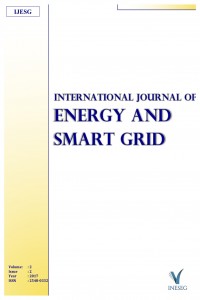Abstract
References
- IEA, World Energy Outlook 2016, www.worldenergyoutlook.org
- Daus J.V., Kharchenko V.V., Assessment of the Applicability of Data on the Intensity of Total Solar Radiation from Various Sources of Actinometric Information (in russian language),Geliotekhnika, 2, (2017), pp. 48-54
- StackhouseP. W., Whitlock C. H. et al, Meeting Energy-Sector Needs with NASA Climate Datasets,Earth Observation Magazine, 11, (2002), pp.6-10
- Meteotest, Meteonorm, 2008.
- Michalsky J., Berndt J. L., A Microprocessor Based Rotating Shadowband Radiometer. Solar Energy,3,(1986), pp.381-479.
- Avezov R.R., Lutpullaev S. L.,The state, prospects and problems of using renewable energy in Uzbekistan. Physics in Uzbekistan,2, (2005), pp.119-123
- UZBTA 8008 ADB Roadmapto solar energy development in Uzbekistan, 2013.
- ]ISO 9060 1990, Solar energy - Specification and classification of instruments for measuring hemispherical solar and direct solar radiation, International Organization for Standardization, 2008.
Abstract
Solar radiation resource data serve as
fundamental information for programs of large-scale deployment of solar energy
technologies. While solar resources in the Republic of Uzbekistan are estimated
to be significant based on limited information, comprehensive understanding
requires considerably more data and analysis in order to optimize the process
of planning and siting solar energy power plants. This paper highlights the
analysis of the four-year of solar resource measurements from new ground meteorological
stations in Uzbekistan which were installed within the framework of the project
of the Asian Development Bank TA 8008 "Development of solar energy in
Uzbekistan" in 2013.The current study should have significant applications
for preliminary technology selection, power plant modeling, and resource
forecasting. The analysis uses4-year (January 2013–December 2016) data from 6
stations located in the south-eastern part of the republic based on ten-minute
measurements of Global Horizontal Irradiance (GHI), Diffuse Horizontal
Irradiance (DHI), Direct Normal Irradiance (DNI), and related meteorological
parameters.
References
- IEA, World Energy Outlook 2016, www.worldenergyoutlook.org
- Daus J.V., Kharchenko V.V., Assessment of the Applicability of Data on the Intensity of Total Solar Radiation from Various Sources of Actinometric Information (in russian language),Geliotekhnika, 2, (2017), pp. 48-54
- StackhouseP. W., Whitlock C. H. et al, Meeting Energy-Sector Needs with NASA Climate Datasets,Earth Observation Magazine, 11, (2002), pp.6-10
- Meteotest, Meteonorm, 2008.
- Michalsky J., Berndt J. L., A Microprocessor Based Rotating Shadowband Radiometer. Solar Energy,3,(1986), pp.381-479.
- Avezov R.R., Lutpullaev S. L.,The state, prospects and problems of using renewable energy in Uzbekistan. Physics in Uzbekistan,2, (2005), pp.119-123
- UZBTA 8008 ADB Roadmapto solar energy development in Uzbekistan, 2013.
- ]ISO 9060 1990, Solar energy - Specification and classification of instruments for measuring hemispherical solar and direct solar radiation, International Organization for Standardization, 2008.
Details
| Journal Section | Research Article |
|---|---|
| Authors | |
| Publication Date | December 30, 2017 |
| Published in Issue | Year 2017 Volume: 2 Issue: 2 |
All articles published by IJESG are licensed under the Creative Commons Attribution 4.0 International License. This permits anyone to copy, redistribute, remix, transmit and adapt the work provided the original work and source is appropriately cited.


